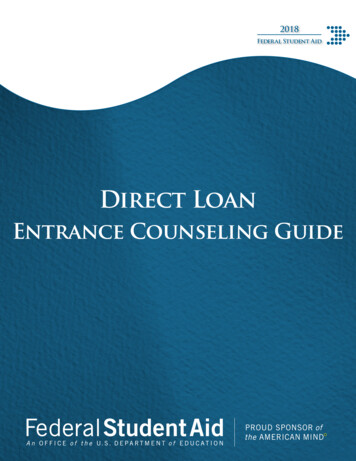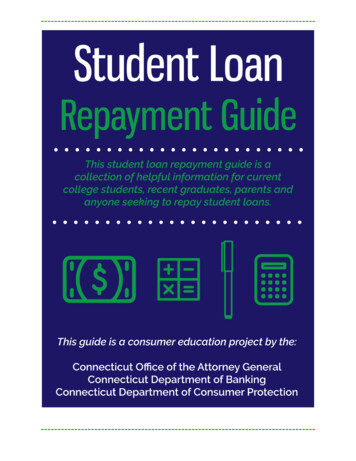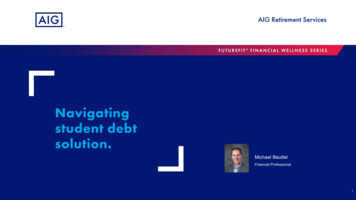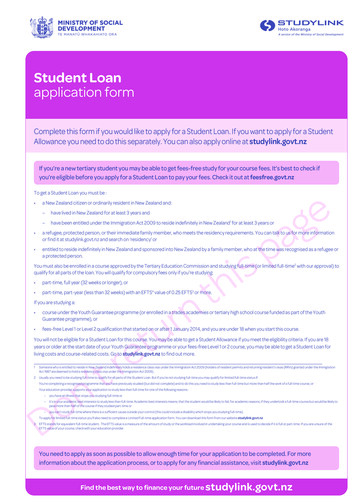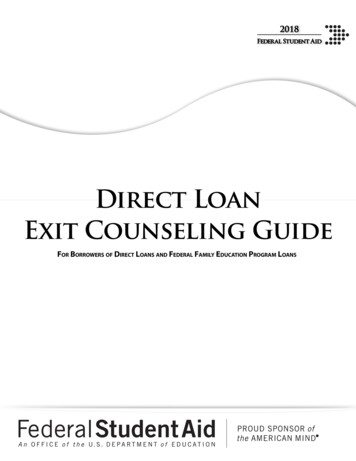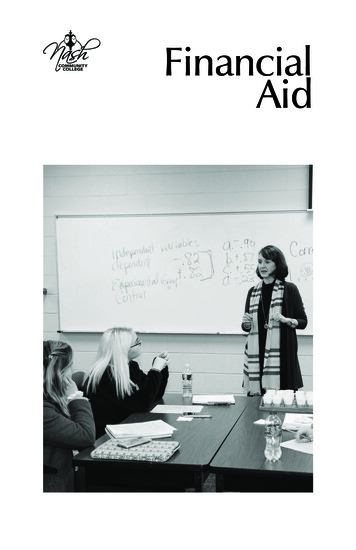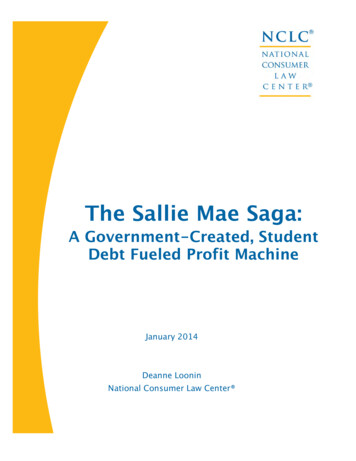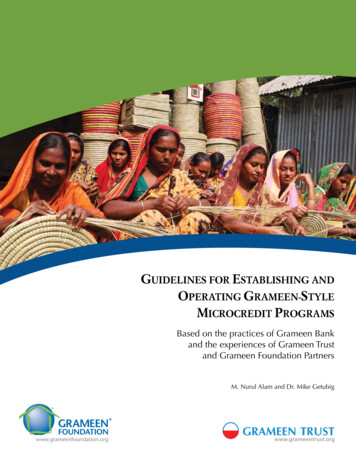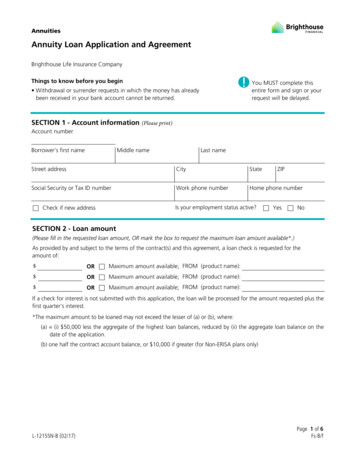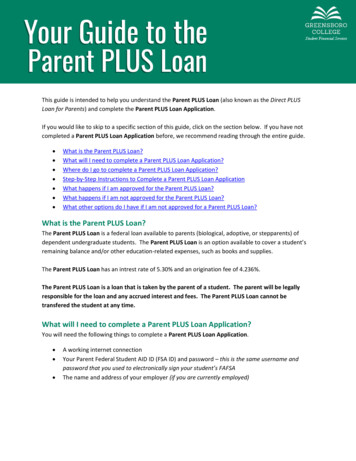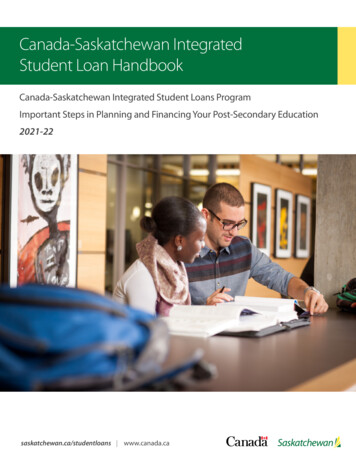
Transcription
Canada-Saskatchewan IntegratedStudent Loan HandbookCanada-Saskatchewan Integrated Student Loans ProgramImportant Steps in Planning and Financing Your Post-Secondary Education2021-22saskatchewan.ca/studentloans www.canada.ca
Table of ContentsIntroduction. . . . . . . . . . . . . . . . . . . . . . . . . . . . . . . . . . . . . . . . . . . . . . . . . . . . . . . . . . . . . . . . . . . . . . . 1New in 2021-22 . . . . . . . . . . . . . . . . . . . . . . . . . . . . . . . . . . . . . . . . . . . . . . . . . . . . . . . . . . . . . . . . . . . . 1Eligibility Criteria. . . . . . . . . . . . . . . . . . . . . . . . . . . . . . . . . . . . . . . . . . . . . . . . . . . . . . . . . . . . . . . . . . 1Residency . . . . . . . . . . . . . . . . . . . . . . . . . . . . . . . . . . . . . . . . . . . . . . . . . . . . . . . . . . . . . . . . . . . . . . . . . . . . . . . .2Student Categories. . . . . . . . . . . . . . . . . . . . . . . . . . . . . . . . . . . . . . . . . . . . . . . . . . . . . . . . . . . . . . . . . . . . . . .2Canada and Saskatchewan Student Grants . . . . . . . . . . . . . . . . . . . . . . . . . . . . . . . . . . . . . . . . . . 3Assistance and Benefits. . . . . . . . . . . . . . . . . . . . . . . . . . . . . . . . . . . . . . . . . . . . . . . . . . . . . . . . . . . . 3Maximum Weekly Levels of Assistance . . . . . . . . . . . . . . . . . . . . . . . . . . . . . . . . . . . . . . . . . . . . . . . . . . . .4Additional Assistance for Low-Income Students with Dependents . . . . . . . . . . . . . . . . . . . . . . . . .4Grants for Students with Permanent Disabilities . . . . . . . . . . . . . . . . . . . . . . . . . . . . . . . . . . . . . 5Applying for Full-Time Student Financial Assistance . . . . . . . . . . . . . . . . . . . . . . . . . . . . . . . . . 6Online Application and Upload Features. . . . . . . . . . . . . . . . . . . . . . . . . . . . . . . . . . . . . . . . . . . . . . . . . . 6How Assistance is Calculated. . . . . . . . . . . . . . . . . . . . . . . . . . . . . . . . . . . . . . . . . . . . . . . . . . . . . . . . 7Allowable Expenses. . . . . . . . . . . . . . . . . . . . . . . . . . . . . . . . . . . . . . . . . . . . . . . . . . . . . . . . . . . . . . . . . . . . . . 7Expected Contributions . . . . . . . . . . . . . . . . . . . . . . . . . . . . . . . . . . . . . . . . . . . . . . . . . . . . . . . . . . . . . . . . . . 8Student Financial Assistance for Part-Time Studies. . . . . . . . . . . . . . . . . . . . . . . . . . . . . . . . . 12Canada Student Loans for Part-Time Studies . . . . . . . . . . . . . . . . . . . . . . . . . . . . . . . . . . . . . . . . . . . . 12Canada/Saskatchewan Student Grant for Part-Time Studies. . . . . . . . . . . . . . . . . . . . . . . . . . . . . 12Canada Student Grant for Part-Time Students with Dependants . . . . . . . . . . . . . . . . . . . . . . . . . 12Part-Time Master Student Financial Assistance Agreement (MSFAA). . . . . . . . . . . . . . . . . . . . . 12Receiving Your Funds . . . . . . . . . . . . . . . . . . . . . . . . . . . . . . . . . . . . . . . . . . . . . . . . . . . . . . . . . . . . . 13Your First Student Loan Application . . . . . . . . . . . . . . . . . . . . . . . . . . . . . . . . . . . . . . . . . . . . . . . . . . . . . 13Maintaining Your Eligibility While in School . . . . . . . . . . . . . . . . . . . . . . . . . . . . . . . . . . . . . . . . 14Your Responsibilities . . . . . . . . . . . . . . . . . . . . . . . . . . . . . . . . . . . . . . . . . . . . . . . . . . . . . . . . . . . . . . . . . . . . 14Keeping Government Student Loans Interest-Free. . . . . . . . . . . . . . . . . . . . . . . . . . . . . . . . . . . . . . . 15
Repaying Your Student Loan. . . . . . . . . . . . . . . . . . . . . . . . . . . . . . . . . . . . . . . . . . . . . . . . . . . . . . 15Consolidating Your Loan. . . . . . . . . . . . . . . . . . . . . . . . . . . . . . . . . . . . . . . . . . . . . . . . . . . . . . . . . . . . . . . . 15Interest on Canada Student Loans . . . . . . . . . . . . . . . . . . . . . . . . . . . . . . . . . . . . . . . . . . . . . . . . . . . . . . 16Interest on Saskatchewan Student Loans. . . . . . . . . . . . . . . . . . . . . . . . . . . . . . . . . . . . . . . . . . . . . . . . 16Maintaining Your Loan While in Repayment. . . . . . . . . . . . . . . . . . . . . . . . . . . . . . . . . . . . . . . . . . . . . 16Repayment Assistance Plan – Permanent Disability . . . . . . . . . . . . . . . . . . . . . . . . . . . . . . . . . . . . . 16Revision of Terms. . . . . . . . . . . . . . . . . . . . . . . . . . . . . . . . . . . . . . . . . . . . . . . . . . . . . . . . . . . . . . . . . . . . . . . 17Loan Forgiveness for Nurses and Nurse Practitioners. . . . . . . . . . . . . . . . . . . . . . . . . . . . . . . . . . . . . 17Loan Forgiveness for Veterinarians and Veterinary Technicians. . . . . . . . . . . . . . . . . . . . . . . . . . 17Bankruptcy and Overpayments. . . . . . . . . . . . . . . . . . . . . . . . . . . . . . . . . . . . . . . . . . . . . . . . . . . 17Bankruptcy . . . . . . . . . . . . . . . . . . . . . . . . . . . . . . . . . . . . . . . . . . . . . . . . . . . . . . . . . . . . . . . . . . . . . . . . . . . . . 17Overpayments. . . . . . . . . . . . . . . . . . . . . . . . . . . . . . . . . . . . . . . . . . . . . . . . . . . . . . . . . . . . . . . . . . . . . . . . . . 17Falsified Information. . . . . . . . . . . . . . . . . . . . . . . . . . . . . . . . . . . . . . . . . . . . . . . . . . . . . . . . . . . . . . . . . . . . 18Student Financial Assistance Scholarships. . . . . . . . . . . . . . . . . . . . . . . . . . . . . . . . . . . . . . . . . 19Contact Information. . . . . . . . . . . . . . . . . . . . . . . . . . . . . . . . . . . . . . . . . . . . . . . . . . . . . . . . . . . . . . 20Glossary. . . . . . . . . . . . . . . . . . . . . . . . . . . . . . . . . . . . . . . . . . . . . . . . . . . . . . . . . . . . . . . . . . . . . . . . . 21
IntroductionThe Government of Canada and the Governmentof Saskatchewan work together to provide studentfinancial assistance (referred to as “assistance”) inSaskatchewan. Loans and grants are available tohelp full-time and part-time students access andafford post-secondary education. This handbookprovides Saskatchewan students with informationabout assistance for the 2021-22 loan year(August 1, 2021 to July 31, 2022).Assistance is meant to supplement, not replace,other resources to pay for post-secondaryeducation. You may want to look at other optionsto help with your costs such as: Employment; Internship or co-op programs offered for yourprogram of study; Bursaries, grants and scholarships; Savings; and Funding from parents and relatives.New in 2021-22Effective August 1, 2021, the following changesare incorporated in to the Integrated CanadaSaskatchewan Student Loan assessment for new andreturning students in the 2021-22 academic year. The Saskatchewan Advantage Scholarship isincreasing from 500 to 750 per year. Thelifetime maximum for this scholarship is alsoincreasing from 2,000 to 3,000.Expected contributions from students andspouses/common-law partners will return instudents’ needs assessments.Doubling the Canada Student Grants (CSGs)for all eligible full-time(FT) and part-time (PT)students, as well as the CSGs for Students withPermanent Disabilities (PD) and Students withDependents (DEP), for the 2021-22 and 2022-23school years.saskatchewan.ca/studentloans »CSG-FT is up to a maximum of 750 permonth of study, or 6,000 for a standard8-month academic year»CSG-PT is up to a maximum of 3,600.»CSG-FTDEP is up to a maximum of 400 perdependent, per month of study, or up to 3,200 for a standard 8-month loan year»CSG-PTDEP is a maximum of 3,840.»CSG-PD is a maximum of 4,000.The maximum weekly Canada Student Loanamount that can be provided to a student forthe 2021-22 loan year will return to 210.Eligibility CriteriaYou are eligible to apply for full-time assistance inSaskatchewan if: You are a Saskatchewan resident, as defined bythe program; You are a Canadian citizen, permanent residentor a protected person; You have financial need according to programcriteria; You are enrolled or qualified to enrol at adesignated school in an approved programwhich is at least 12 weeks in length and leadsto a degree, diploma or certificate. If yourprogram has a period or periods of study of sixto 11 weeks, you may be eligible if the shorterperiods of study are part of a longer program; You will be taking at least 60 per cent of a fullcourse load, or 40 per cent if you are a studentwith a permanent disability; Your previous student loans are in goodstanding (i.e., you must not have defaulted on aprevious student loan); You pass a credit check if you are 22 years ofage or older and applying for assistance for thefirst time; and You have not exhausted the lifetime maximumassistance limit:1
340 weeks (including interest-free status) ofassistance;A Single Dependant Student:»400 weeks for students in doctoral studies;or Has no children; and »520 weeks for students with a permanentdisability.Has been out of high school for less than fouryears before the first day of class of the currentstudy period; or Has been in the work force for less than twoyears (two periods of 12 consecutive months)before the first day of class of the current studyperiod.»Check with your school to ensure it is designatedfor the purposes of student loans or visit www.canada.ca/student-financial-assistance for a list ofdesignated educational institutions. Your schoolmust be designated in order for you to receivefunding. If you have questions regarding a school’sdesignation, please contact the Student ServiceCentre.ResidencyIf you have lived in Saskatchewan for at least 12consecutive months before the first day of yourstudy period (excluding time spent as a full-timestudent in a post-secondary education program)you are considered a Saskatchewan resident.DO NOT APPLY TO MORE THAN ONE PROVINCE.Read the Saskatchewan Residency questions on theapplication and contact the Student Service Centerif you require additional help.Student CategoriesWhen you apply for full-time assistance, you will beclassified as belonging to one of the following fourcategories. This category will help to determinehow your financial need is calculated:2A Single Independent Student: Has no children; and Has been out of high school for four years ormore before the first day of class of the currentstudy period; or Has been in the workforce for at least two years(two periods of 12 consecutive months) beforethe first day of class of the current study period.A Married Student: Is legally married; or Is in a common-law relationship (i.e., living withthe person you are in a relationship with for aminimum of 12 consecutive months before thefirst day of class of the current study period).A Single Parent Student: Has custody of one or more children at least 50per cent of the time; and Is not married or common-law.2021-22 Canada-Saskatchewan Integrated Student Loan Handbook
Canada and SaskatchewanStudent GrantsWhen you apply for a Canada-SaskatchewanIntegrated Student Loan, you will be automaticallyconsidered for student loans and grants from boththe Government of Canada and the Government ofSaskatchewan. Grant amounts are calculated basedon your number of weeks of study, the previousyear’s family income and family size. A separateapplication is only required for the CanadaSaskatchewan Grant for Services and Equipment forStudents with Permanent Disabilities.Your application for a Canada-SaskatchewanIntegrated Student Loan will be assessed for amixture of non-repayable grants and repayableloans. You may request to only receive nonrepayable grant funding and decline repayable loanfunding. If you choose to receive only grant fundingand, in the future, you need to access loan funding,you can contact the Student Service Centre andseek a reassessment and receive the loan fundingyou are entitled to.Assistance and BenefitsPost-secondary education is a worthwhileinvestment but it is also a serious commitment.Being financially prepared means knowing howmuch your education will cost and making decisionsFamilysize1234567 Previous Year’s Gross Annual FamilyIncome for Maximum Grant Amount 32,102 or less 45,399 or less 55,602 or less 64,204 or less 71,782 or less 78,634 or less 84,933 or lesssaskatchewan.ca/studentloansabout how you will meet your financial needs.When planning for your education, you shouldconsider tuition costs, text books and learningmaterials, as well as transportation and living costswhile in school.The amount of assistance you can receive, includingany grants, depends on your situation. The Noticeof Assessment you receive after applying forassistance will outline your eligibility for bothprovincial and federal assistance.Grants are available to students from low- andmiddle-income families, students with permanentdisabilities, adult and low- and middle-income adultlearners. Grants do not need to be paid back andstudents may be eligible to receive more than onegrant at a time.Loans are available to higher-income students.The loans are interest-free while you are in schooland you don’t have to start repaying them until sixmonths after you complete your studies. Keep inmind, interest does accrue during that six-monthperiod.The Canada Student Grant, Saskatchewan StudentGrant and the Canada Student Grant for studentswith dependants are progressive grants that aredependent on family income and family size. Thegrants progressively decline as annual incomeincreases. Income thresholds are outlined in thefollowing table.Previous Year’s Gross AnnualFamily Income for No Grant 63,615 or more 89,004 or more 106,278 or more 117,021 or more 126,929 or more 136,326 or more 144,457 or more3
Maximum Weekly Levels of AssistanceThe student grants and loans are pro-rated weekly to accommodate varying program lengths. The tablesbelow outline the maximum weekly levels of assistance which also depends on the type of educationalprogram.CanadaStudentGrantSkills Boost Topup to the CanadaStudent LoanWeekly AssistanceStudents in One Year andGraduate Programs 0 0 210 30 168 408Students in Multiple YearCertificate, Diploma orUndergraduate Programs 174 47 210 30 110 524Medical Students 174 47 210 0 365 749CanadaStudentGrantSkills Boost Topup to the CanadaStudent LoanWeekly AssistanceStudents in One Year andGraduate Programs 0 0 210Up to 30Up to 198Up to 408Students in Multiple YearCertificate, Diploma orUndergraduate ProgramsUp to 174 47 210Up to 30Up to 227Up to 524Medical Studentsup to 174 47 210 0 365Up to 749CanadaStudentGrantSkills Boost Topup to the CanadaStudent LoanWeekly AssistanceStudents in One Year andGraduate Programs 0 0 210 0 198 408Students in Multiple YearCertificate, Diploma orUndergraduate Programs 0 0 210 0 198 408Medical Students 0 0 210 0 365 575Low-Income Students(Full grant amount eligible)Middle-Income Students(Progressive Grant Eligible)Above Grant EligibleIncome ThresholdThere is 100 minimum for the Canada Student Grant and 100 minimum for the Saskatchewan Student Grant.*The top-up grant is for adult learners only. To qualify a student must have been out of high-school for at least 10 years.Additional assistance above the weekly maximums listed above include:*Students with dependent children:Additional Assistance for Low-IncomeStudents with DependentsDependents Under 12 and Dependents over 12 withPermanent DisabilityDependents Between 12 and 18Canada Student GrantSaskatchewan Student Grant 100 minimum upto 93 per child 0 0 0Additional Assistance for Students with Permanent DisabilitiesCanada Student Grant of 4,000/loan year. There is no weekly calculation for this grant.42021-22 Canada-Saskatchewan Integrated Student Loan Handbook
Grants for Students with Permanent DisabilitiesStudents with Permanent DisabilitiesCanada Grant for Students with Permanent DisabilitiesCanada-Saskatchewan Grant for Services andEquipment for Students with Permanent DisabilitiesCanadaStudent Grant 4,000 per yearUp to 20,000per yearSaskStudent GrantUp to 2,000per yearIf you are a student with a permanent disability that restricts your physical or mental ability to performdaily activities necessary to participate fully in post-secondary studies or the work force, you may beeligible for additional assistance.To be considered for the grants, you must apply andqualify for a student loan (either afull-time or part-time loan) and supplydocumentation verifying your permanent disability.You may also be eligible to receive full-timeassistance while studying between 40 and 59 percent of a full course load.Canada Grant for Students with PermanentDisabilitiesThis grant provides 4,000 per year to help coverliving expenses, tuition, and books. Eligibilityfor this grant is determined when you apply forassistance. A separate application form is katchewan Grant for Servicesand Equipment for Students with PermanentDisabilitiesThis federal grant provides up to 20,000 peryear for exceptional education-related costs suchas tutors, note-takers, interpreters, braillers, ortechnical aids. If your need exceeds the amountavailable from the Canada Grant for Servicesand Equipment for Students with PermanentDisabilities, the Saskatchewan Grant for Servicesand Equipment for Students with PermanentDisabilities may provide up to 2,000 in additionalassistance.A separate application is required for this grant.Your disability advisor at your school can help youcomplete the application.5
Applying for Full-Time Student Financial AssistanceSubmit your online application early to ensure thatyou receive your funds at the start of your schoolterm.You can also scan completed forms and uploadthem to your Advanced Education Student Portalaccount using the upload feature.Applications for the upcoming loan year areavailable in late June. You only have to fill outone application to be considered for a CanadaSaskatchewan Integrated Student Loan and grants.If you do not have an Advanced Education StudentPortal account or need to submit documents onbehalf of the applicant, you can upload documentsusing the Post-Secondary Document Uploader.Online Application and Upload FeaturesIf you have questions or need help with yourapplication contact the Student Service Centre:You can apply directly online through the AdvancedEducation Student Portal by creating a new accountor using your existing one.1-800-597-8278 toll-free within Canada306-787-5620 in the Regina area or outside CanadaEmail: studentservices@gov.sk.caBefore Classes BeginThree months before program start dateComplete your online application. Submit your requireddocuments to the Student Service Centre.When you receive your Notice of Assessmentand, if you are a new applicant, instructions tocomplete the online Master Student FinancialAssistance Agreement (MSFAA)New applicants must complete the two-step online MSFAA withthe National Student Loans Service Centre (NSLSC). If you havealready signed a MSFAA you do not need to sign a new agreement.See Receiving Your Student Loan section for more information.Classes BeginStart of classesThe full amount of your Canada Student Loan and the first halfof your Canada Student Grant will be paid. Your educationalinstitution may request all or a portion of the Canada funding.The first half of your Saskatchewan Student Grant will be paiddirectly to your bank account.Second month of classesFirst monthly payment of Saskatchewan Student Loan is paid.Payments will continue monthly until the last month of your studyperiod. Your payment will be deposited directly into your bankaccount.Mid-point of classesSecond payment of the Canada Student Grants and of theSaskatchewan Student Grant.While in schoolInform the Student Service Centre immediately of any changes tocourse load, income or personal information.Program EndsApproximately five months after end date(unless NSLSC is notified of return tofull-time studies)Consolidation Letter is sent from the NSLSC.First day of seventh month (unless NSLSC isnotified of return to full-time studies)First loan payment due.Note: Applications and any changes must be received 14 business days before your program end date toallow time for processing.62021-22 Canada-Saskatchewan Integrated Student Loan Handbook
How Assistance is CalculatedFinancial need is the amount you require to helpyou meet your financial commitments.The formula to calculate the amount of assistanceyou will receive is as follows:Your Allowable Expenses minus Your ExpectedContributions Your Financial NeedExample Scenarios A student attending a full-time college oruniversity program can expect to pay between 5,000 and 8,500 per year in tuition. Livingexpenses will vary depending on if you liveat home with your parents and/or spouse orrelocate to complete your education. If you are a single student and live at homewhile studying, your total expenses should beabout 7,000 to 10,000, depending on yourprogram of study. If you are single and live awayfrom home, you can expect your expenses tobe 11,000 to 15,000. If you have dependentchildren, the cost will be higher.Tip! www.canada.ca/student-financialassistance offers a variety of online toolsto help you determine education costs andbudget your finances.Student CategoryAllowable ExpensesYour assistance covers the following allowableexpenses:Educational ExpensesAllowable educational expenses include the actualcosts of tuition and compulsory fees. Books andsupplies will be allowed as an expense up to amaximum of 3,000.Living AllowanceYour living allowance provides money forshelter, food, miscellaneous items and localpublic transportation. If you are a single studentliving away from home, the shelter allowanceis based on the expectation that you will shareaccommodations. Your living allowance isdetermined by your student category, familysize, and province where you are studying. Theallowance is a standard allowance for a moderatestandard of living based on Statistics Canada’sFamily Expenditure Survey.As a single student or a married student livingin a different community than the family home(your parents or spouse), an allowance will also beincluded for one return trip home for each periodof 16 weeks, to a maximum of 600 per trip.Saskatchewan Monthly Living AllowancesApproximate monthly living allowanceSingle student living at home 551Single student living away from home 1,262Married student and spouse with child(ren) 2,453 621 for each childSingle parent with child(ren) 1,649 621 for each childNote: These allowances are used to calculate your financial need. They are not the monthly amount youmay receive.saskatchewan.ca/studentloans7
Number of Children1Saskatchewan Monthly Daycare AllowancesSubsidizedUnsubsidized 85 4002 170 540 2703 255 680 3404 or more 340 820 410Daycare AllowanceIf you have dependant children under 12 yearsof age and you require full-time daycare, theallowable expense will be based on whether ornot your daycare costs are subsidized. A 20 perday incidental rate, up to the maximums outlinedbelow, may be allowed upon a written request forreview. See table above.Retroactive Child Care Subsidy PaymentsUpcoming retroactive child care subsidy paymentsare exempt from student loans needs assessmentsfor the 2021-22 academic year. Retroactivepayments received do not have to be declared foryour student loans.Child Support and/or AlimonyIf you or your spouse are making child support and/or alimony payments, you can claim this expenseup to a maximum amount of 605 per child permonth.Expected ContributionsStudent ContributionThe student contribution is comprised of: The fixed student contribution up to 3,000 perloan year (described below): Any scholarship or bursary more than 1,800received in one loan year (e.g., universityentrance scholarships, doctoral fellowships, andprivate sector scholarship funds); and 100 per cent of all other funding you receivespecifically to attend school such as trainingallowances from private sector or governmentexcluding funding provided by thePost-Secondary Student Support Program8Incidental Maximum 200(PSSSP), the Métis Nation Post-SecondaryEducation Strategy and the Inuit Post-SecondaryEducation Strategy to eligible indigenousstudents.Fixed Student ContributionStudents are expected to contribute to theireducational costs by providing a fixed studentcontribution up to 3,000 per loan year, with theexact amount being calculated based on their grossfamily income and family size.Students are expected to use their income, assets,and other resources to make a fixed studentcontribution to their education costs each year.There is no fixed student contribution forIndigenous students, students with permanentdisabilities, students with children and studentswho are, or where, Crown wards.Students with gross family income from theprevious year equal to or below the low-incomethreshold will contribute 1,500 for an eight-monthacademic year.A previous year’s gross family income is defined bystudent category:FamilySize1234567 Previous Year’s Gross Family Incomefor Fixed Student Contribution 31,243 44,184 54,114 62,485 69,861 76,529 82,6602021-22 Canada-Saskatchewan Integrated Student Loan Handbook
Independent students and single parents: familyincome is comprised of the student’s incomeonly (found on Line 150 of the student’s previousyear’s T1 General Income Tax Form). Dependant students: family income iscomprised of the student’s parental incomeonly, which is used as a proxy for the dependantstudent (found on Line 150 of each parent’sprevious year’s T1 General Income Tax Form). Married/common-law students: family incomeis comprised of the student’s income andspouse’s or partner’s income (found on Line 150of their respective previous year’s T1 GeneralIncome Tax Form).Students with gross family income from theprevious year above the low-income threshold willcontribute 1,500 for an eight-month academicyear plus an additional 15 per cent of income abovethe threshold to a maximum total contribution of 3,000.The expected fixed contribution will be pro-ratedweekly. The weekly minimum contribution is 44per week up to the maximum weekly contributionof 87 per week. The number of study weeks usedto determine the fixed student contribution iscapped at 34 weeks (i.e., an eight-month academicyear) for each loan year. This means that no studentcontribution will be calculated for more than 34weeks even if the period of study is longer.Example: Single independent student with previousyear’s gross income of 35,000 going to school fromSeptember to April (8 months). 44 (15% x (A - B) x (1/8) x 12 x (1/52)) x 34 weeks A is the prior year’s gross family income (fromLine 150 of the T1 General Income Tax Form); B is the gross annual family income thresholdfor the corresponding family size (see previoustable); and 44 is the minimum contribution ( 87 ismaximum contribution).(15% x ( 35,000 - 31,243) x (1/8) x 12 x (1/52)) 16.26/weekSpousal ContributionThe income amount used to determine the fixedspousal contribution is the same as the familyincome used to calculate the fixed studentcontribution. The fixed spousal contribution for astudent with a family income below the low-incomethreshold will be 0. For income above the lowincome threshold, the contribution will be 10 percent on the amount of family income above the lowincome threshold. No fixed spousal contributionsare expected from spouses who are studentsthemselves, spouses in receipt of EmploymentInsurance benefits or social assistance, and spousesin receipt of federal or provincial disability benefits.The expected fixed spousal contribution will beprorated weekly. The number of study weeks usedto determine the fixed spousal contribution iscapped at 34 weeks (i.e., an eight-month academicyear) for each loan year. This means that no spousalcontribution will be calculated for more than 34weeks even if the period of study is longer.Example: Married student (no children) going toschool from September to April (8 months) witha previous year’s income of 25,000 plus theirspouse’s previous year’s income of 30,000 givesthem a gross family income of 55,000.10% x (A - B) x (1/8) x 12 x (1/52) A is the prior year’s gross annual family income(student plus spouse); and B is the gross annual low-income threshold (seetable in previous section).10% x ( 55,000-44,184) x (1/8) x 12 x (1/52) 31.20/week 31.20/week x 34 weeks 1,061 SpousalContributionPlus the student fixed contribution:15% x ( 55,000-44,184) x (1/8) x 12 x (1/52) 46.80/week 44 46.80/week 90.80 however the maximumis 87/weekTherefore 87/week x 34 weeks 2,958 Student Contribution 44 16.26/week 60.26 x 34 weeks 2,049 Contributionsaskatchewan.ca/studentloans9
Parental ContributionIf you are a single dependant student, your parentsare expected to contribute towards your education,based on their discretionary income. Discretionaryincome is their combined income in the lastcomplete taxation year, after deductions for incometax, Canada Pension Plan, Employment Insurance,and a moderate standard of living, based on familysize. Parents, their
The maximum weekly Canada Student Loan amount that can be provided to a student for the 2021-22 loan year will return to 210. Eligibility Criteria You are eligible to apply for full-time assistance in Saskatchewan if: You are a Saskatchewan resident, as defined by the program; You are a Canadian citizen, permanent resident
